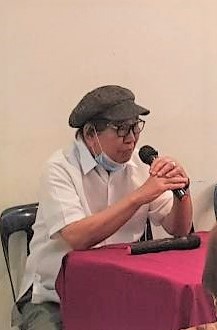Pasig During the Second Word War -- The Need for a Continuing Narrative (Part I)
Manolo Lozada was one of our storytellers in yesterday's event at the Samahang Pangkasaysayan ng Pasig (SPP) forum, marking the anniversary of the start of World War II in the Pacific. He was our weaver of tales that are gradually fading from the collective consciousness of many Pasiguenos—the war years of the 1940s.
Manolo Lozada's narrative began from the moment the news of the Japanese attack on Pearl Harbor reached Pasig, precisely on the 8th of December 1941, the feast of the Virgin Mother—Pista ng Bayan. People started to gather around the plaza. When mass ended, some men loitered around to discuss the situation. The women and children dispersed and went home. It was probably one of the bleakest town fiestas, with people celebrating but unsure of what lies ahead. With uncertainty about how to react, Pasiguenos faced the dilemma of celebrating the town fiesta or preparing for the imminent war. Some food on the tables was said to remain untouched.
As the Japanese forces arrived in Pasig, panic spread, prompting some residents to flee to the remote areas of Rizal Province—Antipolo, Angono, Binangonan. Many Pasiguenos even dug air raid shelters on their properties. Unfortunately, some encountered the grim fate of crossing paths with Japanese brutalities. Manolo Lozada pointed out locations where several Pasiguenos were executed—the section of what is now Rizal High School in Caniogan. He poignantly described the accounts of Pasiguenos witnessing executions under the acacia trees, their headless bodies reported to still be moving, even running, after the fatal strikes.
Yet, amid the brutality, there was humanity. The Lozadas' house became a haven for some Japanese officers. Mr. Manolo's mother, a pianist, filled the house with classical music, providing a glimpse into souls profoundly changed by war. These Japanese officers came to listen, perhaps seeking solace in the midst of the conflict. As the end neared, with the imminent return of the Americans, the Japanese officers were described by Manolo Lozada as "in tears, nag iiyakan," bidding farewell to friends they had initially treated as conquered enemies.
In conclusion, Manolo Lozada posed a poignant question: "What is such a war that it can turn a beast out of man? What kind of heart do such people possess?" This was how Manolo Lozada concluded his narratives.
There is indeed a need for a continuing narrative.
 |
| Mr. Manolo Lozada -Speaking during SPP's Public Forum about World War II in Pasig |
 |
| The iconic Dimas-Alang Bakery. Owned and operated by the family of Manolo Lozada. One of the oldest bakery in the country. |
 |
| SPP members with speakers and participants of the "Balik Tanaw -Pangalawang Giyerang Pandaigdig Sa Pasig". |

.png)


Comments
Post a Comment